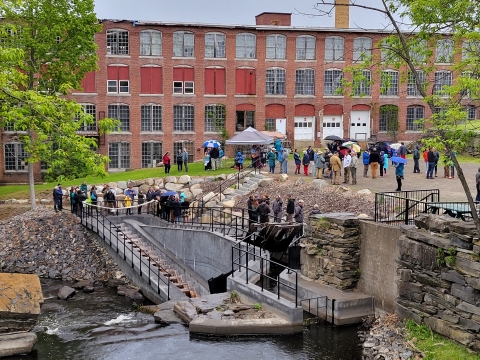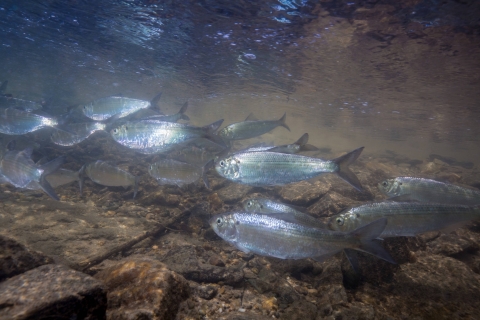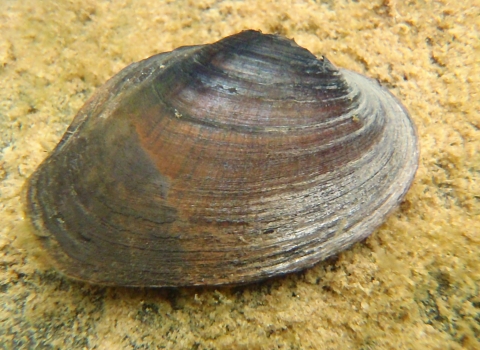The last time an alewife reached Kennebec County’s China Lake under its own steam – in 1783 -- Maine was part of Massachusetts and the Revolutionary War had just ended.
That is until this spring, when hundreds of thousands of the migratory fish swam the seven miles from the Sebasticook River to China Lake to spawn, after more than two centuries of being absent. With six dams removed or modified for fish passage fish passage
Fish passage is the ability of fish or other aquatic species to move freely throughout their life to find food, reproduce, and complete their natural migration cycles. Millions of barriers to fish passage across the country are fragmenting habitat and leading to species declines. The U.S. Fish and Wildlife Service's National Fish Passage Program is working to reconnect watersheds to benefit both wildlife and people.
Learn more about fish passage , the stream’s historical alewife run is being resurrected.
In coming years, returning alewife numbers could grow to a million, and China Lake Outlet Stream, whose dams powered flour, lumber, and textile mills long ago, could once again contribute to the local economy through a commercial harvest and nature tourism. Healthier wildlife and cleaner water are also perks.
The turnaround is thanks to years of work by residents, conservation groups, and state and federal agencies, who have been promoting stream restoration and fish passage in the area for decades.
A change in course
In 1867, the State of Maine ordered a study to rate the waterpower of its 14 main rivers and their tributaries. It found that China Lake Outlet Stream, with “nine dams erected and the potential for three or four more,” produced 1,600 horsepower, with the potential for 800 more.
It was a sign of the times, when waterways were prized for the energy they generated to manufacture goods.
By the 21st century, the number of dams on the stream was down to six -- none of which produced power — and mills stood vacant, if they stood at all. The public’s view of rivers had also changed, with greater value placed on free-flowing, clean waterways with healthy populations of fish and wildlife.
In 1999, the Edwards Dam, on the Kennebec River in Maine’s capital Augusta, came down, opening the Kennebec from the coast to the Sebasticook River. Nearly a decade later, Fort Halifax Dam at the junction of the two rivers was removed.
Alewives responded in a big way, with a million passing the former Fort Halifax site the following spring. By 2018, the number returning annually to the Sebasticook passed five million—the largest run in the country.
Some of those fish entered China Lake Outlet Stream ... and met up with the Box Mill Dam, an insurmountable obstacle.
“Alewives were knocking on the door,” said Landis Hudson, executive director of Maine Rivers, a nonprofit organization that works to conserve the state’s waterways and took on coordinating and directing what became the China Lake Alewife Restoration Initiative. “We had to go for it because the fish were waiting.”
In fact, Maine Rivers, The Nature Conservancy in Maine, the Maine Department of Marine Resources, the USDA Natural Resources Conservation Service, and the U.S. Fish and Wildlife Service had been preparing the local community for the fish’s arrival for years.
The start of something big
Frank Richards and Nate Gray met in the late 1990s, when Richards, newly elected president of the Webber Pond Association, invited Gray, a young regional biologist with the Maine Department of Marine Resources, to talk with the group about alewives.
The two men hit it off and were soon co-conspirators in pursuit of restoring alewives to Webber Pond, which is connected to the Kennebec by Seven-Mile Stream. Gray taught Richards about migratory fish ecology and human-induced changes in the pond. Richards served as ambassador to the community and coached Gray on messaging.
“People live here for generations,” Richards said. “They know each other, and they’ve known each other for a long time.”
Working closely, they garnered support for stocking alewives in Webber Pond and, eventually, building a fishway at its outlet dam, allowing fish to spawn in the pond for the first time in centuries.
Like many water bodies that receive run-off from agricultural land and homes, Webber Pond had endured algal blooms caused by excess phosphorus. With the return of alewives, however, water quality improved dramatically.
Since Fort Halifax Dam had recently come down, clearing the way from the Kennebec River to China Lake Outlet Stream, Gray set his sights on getting alewives to China Lake, joining forces with Maine Rivers, the China Lake Association, Sebasticook Regional Land Trust, and China Region Lakes Alliance. Standing in the way were the remaining dams, in various states of repair and a mix of private and public ownership.
Gray reached out to Fred Seavey, senior fish and wildlife biologist at the Service’s Maine Field Office, for help.
“We were looking at six dams, some with historical structures, in a seven-mile stretch,” said Seavey, who retired in 2020. “Any recalcitrant landowner could kill the project; you can’t have fish passage at just five dams and achieve your goal.”
Or, as Richards put it, it required a great deal of “human engineering.”
Reaching community consensus
Because they produced hydropower, the Edwards and Fort Halifax dams required federal licensing—and modifications for migratory fish—to operate. The Federal Energy Regulatory Commission ordered the Edwards Dam removed in 1997, and it came down two years later. In 2008, Fort Halifax Dam was removed after the operator decided installing fish passage was cost-prohibitive.
The China Lake Outlet Stream dams were different beasts—small, locally owned, historical structures, some with great cultural value.
“In cases like this,” Landis Hudson said, “it’s personal.”
Seavey suggested putting the fate of the stream—and the alewives—in the community’s hands.
Working with Maine Rivers, he recruited an advisory committee of Vassalboro and China residents to consider the future of the dam at the outlet of China Lake, which is owned by the Town of Vassalboro. It’s the final barrier to alewives moving upstream and the keystone of the whole restoration project.
Seavey shared biological and ecological data with the committee and brought in experts to respond to their concerns.
“Whatever the group had an interest in, we’d address,” he said.
After careful consideration, the advisory committee supported installing a Denil fishway at the outlet dam. It was completed in 2021 and allows alewives to enter China Lake, while maintaining water levels and aesthetic and recreational values.
Customizing solutions
When approaching private dam owners downstream, Seavey used “a coffee-table approach.”
Once he had permission to study a site, he shared his findings with Service fish passage engineer Bryan Sojkowski, who created a conceptual design of the proposed remedy: either removing the dam or building a fishway. They then took the design to the landowner for feedback and proposed modifications to address any concerns.
This iterative process, what Molly Payne Wynne, freshwater program director with The Nature Conservancy, calls “creative compromise,” was key to restoring the river.
“There really isn't a one-size-fits-all approach when it comes to stream connectivity,” she said. “Aquatic connectivity doesn't always mean dam removal. You have to alleviate the anxiety of landowners and municipalities.”
Box Mill Dam, the first barrier on the stream above where it meets the Sebasticook, was particularly challenging. The dam once powered the largest mill in New England — the American Woolen Mill — which still stands. A decade ago, Ray Breton bought the site and revitalized it as an event venue and local landmark. The cascading waterfall over the breached dam was a key feature.
Because appearance was important, Sojkowski designed a concrete Denil fishway painted to match the remnant dam stones. It’s nestled into the stream bank, and a wrap-around walkway lets people watch the fish make their way over the dam.
“The Denil fishway is proven technology specific to river herring like alewives, so we can be confident we'll see a benefit,” Sojkowski said. “It has a smaller footprint than other options, which makes it less noticeable.”
A Denil fishway was the ticket for the next barrier on the stream, as well. Residents have used the impoundment created by Ladd Dam as a swimming and canoeing spot for generations. Because removing the dam would be a blow to the community, demolition was out of the question.
“As wonderful as the fishways are, they’re still second-best to complete restoration,” said Landis Hudson. “You don't get all the benefits of restoration, but it’s important that restoration solutions work for people and wildlife."
Clearing the way
Within the last five years, Matt Streeter, Maine Rivers’ Alewife Restoration Initiative project manager, has overseen either removal or modification of all six barriers to allow fish to pass. The Masse Dam came down in 2017, followed the next year by the Lombard Dam. Fishways were built at Ladd and Box Mill dams in 2019 and 2020. In 2021, the remnants of the Morneau Dam were removed and a fishway was built at the China Lake Outlet Dam.
The 4,000-acre China Lake adds 50% more alewife spawning habitat to the Sebasticook River watershed. The seven-mile stream adds 20% more blueback herring spawning habitat.
The Service supported the projects through technical assistance and funding from the National Fish Passage Program, the Partners for Fish and Wildlife Program, and the Atlantic Coastal Fish Habitat Partnership.
“We’re excited to be part of this comprehensive river restoration that brings together so many projects and partners,” said Cathy Bozek, National Fish Passage Program coordinator for the Service in the Northeast. “Beyond the benefits to migratory fish, a more free-flowing China Lake Outlet Stream contributes to the health of the entire Sebasticook Watershed, and that’s good for people and wildlife. This project is an example of the type of work that will take place under the Bipartisan Infrastructure Law Bipartisan Infrastructure Law
The Bipartisan Infrastructure Law (BIL) is a once-in-a-generation investment in the nation’s infrastructure and economic competitiveness. We were directly appropriated $455 million over five years in BIL funds for programs related to the President’s America the Beautiful initiative.
Learn more about Bipartisan Infrastructure Law .”
Through support provided by the landmark legislation signed by President Biden in November 2021, the Service will help deliver on national priorities, with special emphasis on climate, racial equity, and the economy.
In Fiscal Year 2022, 40 projects in 23 states and Puerto Rico will receive a total of nearly $38 million of this infrastructure funding through the National Fish Passage Program, supporting partnerships to remove barriers to fish passage and restore connected rivers and coasts. In Maine, $350,000 will go toward removing two dams on the Sabattus River, a tributary to the Androscoggin.
A restoration ripple effect
This April, project partners and community members waited expectantly for the first alewives to enter China Lake. Within a few years, they hope to welcome a million more.
“Alewife is a resilient species,” said Hudson. “You pretty much know that they’ll respond to restoration work.”
The young fish that swim to the coast in late summer and early fall will feed everything from seals and birds to commercial catches like cod, haddock, halibut, and tuna. When survivors return as adults four years later, they’ll attract bald eagles, great blue herons, and ospreys.
Those five million fish that return to the Sebasticook River each year? They draw hordes of hungry birds. On one day in 2014, 64 bald eagles were spotted in a five-mile stretch of the river, the most ever documented in New England. Birdwatchers flock to the river to see the birds of prey and will no doubt welcome new opportunities on China Lake Outlet Stream.
In addition to alewife and blueback herring, American eel, sea lamprey, white sucker, and brook trout will benefit from the revitalized stream.
Alewives themselves are a tourist attraction. Each spring, as winter loosens its grip on Maine, millions of the silvery fish head upstream to spawn, and people go to watch. Annual alewife festivals draw thousands of visitors to fishways on the Sebasticook and Damariscotta rivers, boosting local economies. There’s even a Maine Alewife Trail.
And let’s not forget how alewives will improve China Lake’s water quality, benefiting residents and recreationists, as well as those turning their taps in Waterville, whose municipal water supply comes from the lake.
“The ecological benefits of this restoration can't possibly be overstated,” said Gray.
The crustacean connection
The biggest financial payoff for the community may come from the connection between alewives and the state’s iconic meal.
In recent years, as alewife populations have rebounded in Maine, the fish has become popular with the $1.4 billion lobster industry. Lobstermen take advantage of the abundant spring alewife runs, baiting their traps with the fish when other sources are scarce and expensive.
“Alewives as lobster bait went from nothing to a million-dollar industry just like that,” said Frank Richards. “It used to be only environmental folks showed up at hearings [for dam removal projects], but now lobster people do. Fish passage has gotten a big boost in political support from the lobster industry.”
A future commercial alewife harvest was an early part of the restoration plan for China Lake Outlet Stream. Sojkowski designed the fishways for two of the dams — Outlet and Ladd — to include harvest facilities.
Once the spring run reaches a sustainable number, in five or six years, the town can apply to the Maine Department of Marine Resources to establish a commercial alewife fishery. The agency will manage the harvest to ensure that numbers of fish sufficient to sustain the population reach China Lake to spawn each year.
Most towns hire a contractor for the actual harvest and reap 35% of the profits. For Vassalboro, that could mean a dependable $50,000 annual boost to its bottom line.
“This stream will surpass Damariscotta Mills,” said Gray, referring to the popular and successful alewife harvest in Midcoast Maine. “And that’s a sustainable, perpetual revenue source for the town.”
Vassalboro Town Manager Mary Sabins is excited by the prospect. The town has managed an alewife harvest on Webber Pond since 2007, pocketing $28,000 in 2018 alone. More than $375,000 in town funds supported the restoration of China Lake Outlet Stream.
Gray, who is a Vassalboro resident, is all for a new revenue stream for the town. But, with two young sons, the project means much more to him.
“It’s hard to put a price on what a run of fish is worth,” he said. “Not long from now, I'll be a memory, but those fish won't -- they'll be here.”
Thanks to the creativity and persistence of many.







